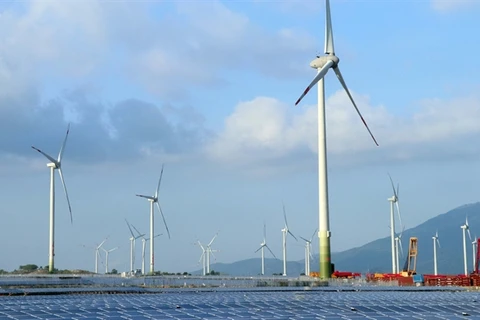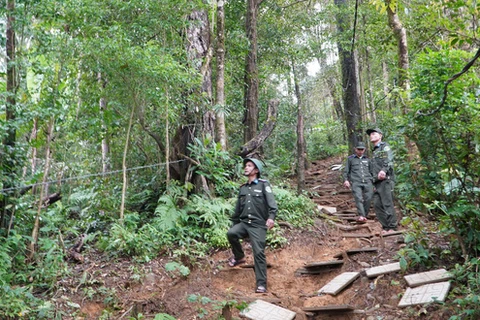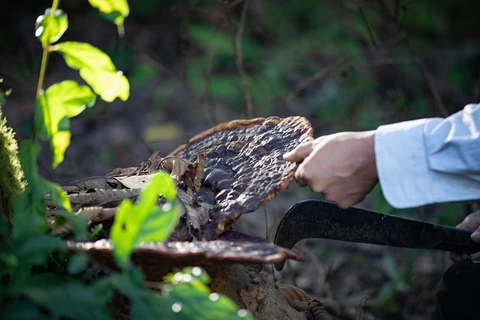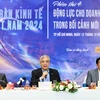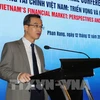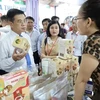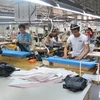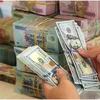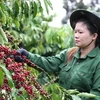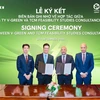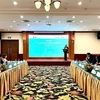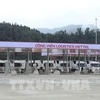 In 2022, the solar power system helps TH Group cut over 4,500 tonnes of CO2 emissions per year. (Photo: VietnamPlus)
In 2022, the solar power system helps TH Group cut over 4,500 tonnes of CO2 emissions per year. (Photo: VietnamPlus) Hanoi (VNA) – Achieving the target of net zero emissions by 2050 is a commitment Vietnam made the 26th United Nations Climate Change Conference (COP26) in 2021. This concrete target is an impetus for both the Government and enterprises to engage in the building of a green and sustainable economy.
Representatives from the Government and businesses shared information and experience in working towards net zero at a workshop on green transition held by VTV in Hanoi on June 27.
The path of reduction - transition - absorption
On the path to the net zero target, TH Group is one of the outstanding performers in Vietnam’s high-tech agriculture sector that have been taking the lead in developing green production and a sustainable economy. From mindset to action or from governance to practice, TH has focused on three aspects: cutting greenhouse gas (GHG) emissions, shifting to green energy and renewable energy sources, and absorbing GHG emissions.
The reduction has been conducted through initiatives on lowering GHG emissions, applying advanced technology, and using renewable energy. In particular, TH Group set the target of bringing down the GHG directly released by its farms and factories by an annual average of 15%. It also eyes cutting the GHG directly or indirectly emitted per product unit at its farms and factories by an annual average of 15%.
Thanks to a large number of comprehensive solutions and strong actions, the farm system of TH reduced the GHG emissions by over 20% per product unit in 2022, higher than the target.
Particularly, the TH Milk Joint Stock Company recorded the GHG emissions at 0.168kg of CO2 per litre of milk in 2019 - 2020. The amount was slashed further to 0.103kg of CO2 per unit in 2022, which is a remarkably low level compared to the emission reduction results of other dairy factories in Vietnam and Southeast Asia.
Also in 2022, TH Group reduced the volume of fuel used at its factories by replacing fossil fuel oil with biomass fuel (wood chips that are by-products of the wood processing industry). Thanks to this move, its entire factory system eliminated the GHG emissions by over 85% compared to 2021.
All the incandescent light bulbs used at the TH farms and factories have been replaced with LED lamps, helping save 5 million kWh of electricity, equivalent to reducing approximately 4,000 tonnes of CO2. This initiative won the consolation prize for energy saving and the Good Energy Manager award presented by the Ministry of Science and Technology.
 TH true marts always use biodegradable plastic bags to help protect the environment. (Photo: VietnamPlus)
TH true marts always use biodegradable plastic bags to help protect the environment. (Photo: VietnamPlus) Shifting to green energy sources, TH Group has applied the word’s most cutting-edge technologies since its first clean fresh milk project. All activities ot the firm has complied with the principle of using environmentally friendly materials, green energy, and renewanable energy.
On the roofs of its factories and dairy farms, TH installed solar power systems, which is not only a source of green electricity but also help the group lower production costs, protect the environment, and contribute to national energy security.
Six farms of this enterprise have used solar energy, meeting one-eighth of their power demand and even one-fifth in summer. Solar power systems have assisted the group to save 29,000 kWh each month, thus reducing a considerable amount of GHG released to the environment.
In 2022, TH farms contributed nearly 7 million kWh to the grid, equivalent to over 4,500 tonnes of CO2 reduced/absorbed each year.
To ensure efficient energy use and minimise CO2 emissions, the group is developing a biomass power project at its NASU Nghe An cane sugar plant that will have total capacity of 30MW during 2023 - 2026. It is also installing more solar power systems at a timber plant in Nghe An province and food factories.
In addition, TH has carried out many energy optimisation solutions to reduce expenses along with GHG emissions to the environment. By 2026, it will also utilise biogas generated from the livestock waste treatment process to serve activities at its farms such as boiling water.
When reduction and transition are maximised, absorption is an important step for TH Group to achieve the net zero target. It is planting as many trees as possible to make up for the CO2 volume released during the production process. The enterprise targets 10,000 trees to be planted per year by 2025.
In the future, the group’s sustainable development committee will strongly implement the TH Tree Fund to directly help absorb CO2, balance emissions and absorption, and create more added values such as developing livelihoods for people and improving the ecosystem, landscapes, and the environment.
Policy support needed for enterprises to join Government’s efforts
Affirming the practice of green economy at TH Group for the last many years, CEO of the TH Milk Joint Stock Company Arghya Mandal said the group aims to achieve the net zero target by 2050. To that end, he put forth three proposals to the Government, including ensuring information transparency and sharing experience from pioneering enterprises, and drawing a detailed roadmap for each period of GHG emission reduction.
 Arghya Mandal, CEO of the TH Milk Joint Stock Company, shares experience in green economic practice. (Photo: VietnamPlus)
Arghya Mandal, CEO of the TH Milk Joint Stock Company, shares experience in green economic practice. (Photo: VietnamPlus) The last but not least is that the Government should issue incentives to encourage enterprises carry out net-zero initiatives. For example, it could exempt or reduce taxes for the enterprises taking part in sustainable development, environmental protection, and afforestation, he went on.
Talking about current policies, Deputy Minister of Planning and Investment Nguyen Thi Bich Ngoc said the Government issued the National Green Growth Strategy that outlines 10 strategic orientations and eight groups of solutions. The national action plan on green growth, also approved by the Government, identifies 18 topics, 57 groups of tasks, and 134 concrete tasks and activities.
With regard to financial policies, Minister of Finance Ho Duc Phoc said that over the last five years, an average of more than 21 trillion VND (847 million USD) from the state budget has been allocated to environment-related activities annually. Funding for green growth has been included in investment priorities of sectors, areas, localities, and target programmes. Spending on environment-related activities during the 2021 - 2025 period is estimated at 23.5 trillion VND.
He affirmed that from now through 2025, the Ministry of Finance will focus on building regulations and policies to create a foundation for the carbon credit market to operate. A carbon credit trading platform will be established and run on a trial basis by 2028. Besides, the ministry is drafting a plan on developing the carbon market to be submitted to the Prime Minister for approval./.
| Tax policies have been aligned with environmental protection as seen in two groups of policies. The first is taxes that aim to curb polluting activities like the tax on environmental protection, the tax on natural resources, and the special consumption tax on polluting products. The second is policies supporting and encouraging environmental protection, pollution reduction, and climate change impact mitigation. At present, the Government imposes a preferential corporate income tax rate of 10% in 15 years, exempts tax for no more than four years, and halves the corporate income tax a company has to pay for no more than nine following years in respect of that firm’s income from new investments in environmental protection. It also regulates that earnings from carbon emission trading do not have to be declared or subject to the value added tax. Besides, the goods and services contributing to greening the economy are not subject to the value added tax. |
